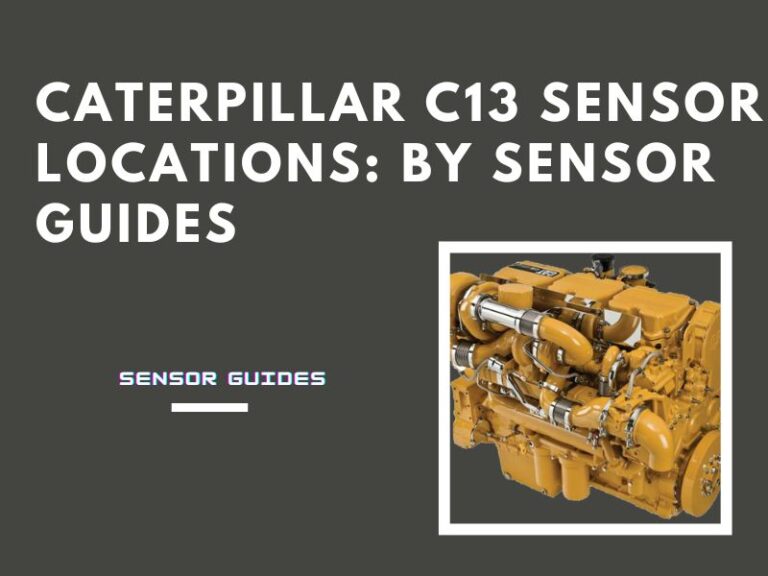6.4 Powerstroke Sensor Locations; All You Need To Know
Explore the vital components of a 6.4 Powerstroke engine with our comprehensive guide on sensor locations. Learn where each sensor is located, how to access them, and their critical roles in optimizing engine performance and reliability. Get all the essential information you need to keep your engine running smoothly.
Table of Contents
Where are the sensors located in 6.4 Powerstroke?
Intake Air Temperature (IAT) Sensor
The Intake Air Temperature (IAT) Sensor on a 6.4 Powerstroke engine is located within the intake manifold. To access it, you may need to remove the intake duct or housing that connects to the intake manifold.
The IAT sensor’s primary function is to measure the temperature of the incoming air as it enters the engine. This temperature data is essential for the engine control unit (ECU) to make precise adjustments to the air-fuel mixture. Cooler air is denser and contains more oxygen, allowing for more efficient combustion and improved engine performance. The IAT sensor’s accurate readings help optimize fuel economy and reduce emissions.
Intake Manifold Absolute Pressure (MAP) Sensor
The Intake Manifold Absolute Pressure (MAP) Sensor in a 6.4 Powerstroke engine is situated within the intake manifold. To access it, you may need to remove the intake duct or housing that connects to the intake manifold, providing access to the sensor.
The MAP sensor plays a crucial role in engine management by measuring the absolute pressure within the intake manifold. This data helps the engine control unit (ECU) calculate engine load and adjust the air-fuel mixture and ignition timing accordingly. Accurate MAP sensor readings are essential for optimizing engine performance, fuel efficiency, and emissions control, making it a vital component of the engine’s control system.
Barometric Pressure (BARO) Sensor
The Barometric Pressure (BARO) Sensor in a 6.4 Powerstroke engine is also located within the intake manifold, typically in close proximity to the Intake Manifold Absolute Pressure (MAP) Sensor. Accessing the BARO sensor may require removing the intake duct or housing connected to the intake manifold.
The primary function of the BARO sensor is to measure the atmospheric pressure outside the engine. This information is used by the engine control unit (ECU) to compensate for changes in altitude and atmospheric pressure, ensuring that the air-fuel mixture and engine performance remain optimal regardless of environmental conditions. It helps maintain engine efficiency and performance under varying driving conditions.
Exhaust Gas Temperature (EGT) Sensor
The Exhaust Gas Temperature (EGT) Sensor in a 6.4 Powerstroke engine is typically located in or near the exhaust manifold. To access it, you may need to reach the exhaust manifold area, which can be challenging due to its proximity to the engine’s hot components.
The primary function of the EGT sensor is to measure the temperature of the exhaust gases as they exit the engine’s cylinders. This information is crucial for monitoring engine performance and ensuring that combustion temperatures remain within safe limits. The EGT sensor data helps the engine control unit (ECU) optimize fuel injection, turbocharger operation, and emissions control to prevent overheating and potential damage to engine components.
Turbocharger BoostPressure (TBP) Sensor
The Turbocharger Boost Pressure (TBP) Sensor in a 6.4 Powerstroke engine is typically located on or near the turbocharger itself, specifically on the intake side. To access it, you may need to locate and access the turbocharger assembly, which is usually positioned near the engine’s intake system.
The primary function of the TBP sensor is to measure the pressure of the compressed air delivered by the turbocharger to the engine’s intake manifold. This pressure data is vital for the engine control unit (ECU) to optimize engine performance by regulating the turbocharger’s boost pressure.
The ECU uses this information to adjust the air-fuel mixture and ignition timing, ensuring efficient combustion and engine power output. Proper TBP sensor readings are essential for maintaining engine performance, fuel efficiency, and emissions control.
Oil Pressure (OP) Sensor
The Oil Pressure (OP) Sensor in a 6.4 Powerstroke engine is typically located on the engine block. Accessing it often involves identifying its position on the engine block, which may require removal of certain components or covers.
The primary function of the Oil Pressure Sensor is to monitor the engine’s oil pressure. This data is crucial for the engine control unit (ECU) to ensure that the engine is receiving adequate lubrication. When the sensor detects low oil pressure, it can trigger warning lights or alerts to the driver.
Maintaining proper oil pressure is vital to prevent engine damage and ensure the longevity of critical engine components by ensuring they receive adequate lubrication. The OP sensor contributes to overall engine health and longevity.
Coolant Temperature (ECT) Sensor
The Coolant Temperature (ECT) Sensor in a 6.4 Powerstroke engine is typically located on the engine block. Accessing it usually involves identifying its position on the engine block, which may require removing certain components or covers.
The primary function of the ECT sensor is to measure the temperature of the engine coolant. This data is essential for the engine control unit (ECU) to monitor and control engine operating temperature. The ECU uses ECT sensor readings to adjust fuel injection, ignition timing, and cooling system operation.
When the engine is cold, the ECU may enrich the air-fuel mixture for easier starting, and when the engine is hot, it may adjust for optimal performance and emissions. Proper ECT sensor data helps maintain engine efficiency and prevents overheating.
Crankshaft Position (CKP) Sensor
The Crankshaft Position (CKP) Sensor in a 6.4 Powerstroke engine is typically located on the engine block near the crankshaft. To access it, you may need to identify its position on the engine block, often on or near the crankshaft itself.
The primary function of the CKP sensor is to monitor the position and speed of the crankshaft as it rotates. This information is crucial for the engine control unit (ECU) to precisely control ignition timing and fuel injection. The CKP sensor helps the ECU determine the top dead center (TDC) of the crankshaft and ensures that combustion events occur at the correct time. Accurate CKP sensor data is essential for optimal engine performance, fuel efficiency, and emissions control.
Camshaft Position (CMP) Sensor
The Camshaft Position (CMP) Sensor in a 6.4 Powerstroke engine is typically located on or near the engine block, close to the camshaft. To access it, you may need to identify its position on the engine block, often near the camshaft itself.
The primary function of the CMP sensor is to monitor the position and speed of the camshaft as it rotates. This information is crucial for the engine control unit (ECU) to precisely control the timing of the engine’s valves and fuel injection events. The CMP sensor helps ensure that the valves open and close at the correct times, coordinating with the piston movements. Accurate CMP sensor data is essential for proper engine performance, fuel efficiency, and emissions control, especially in engines with variable valve timing systems.
Oxygen (O2) Sensor
The Oxygen (O2) Sensor in a 6.4 Powerstroke engine is typically located in or near the exhaust manifold. Accessing it usually involves identifying its position in the exhaust system, which may require accessing the exhaust manifold area.
The primary function of the O2 sensor is to monitor the oxygen content in the exhaust gases. This data is crucial for the engine control unit (ECU) to adjust the air-fuel mixture in real-time. The O2 sensor provides feedback on whether the engine is running rich (too much fuel) or lean (too little fuel), allowing the ECU to make precise adjustments to optimize combustion efficiency. Proper O2 sensor operation is essential for maintaining fuel economy, reducing emissions, and ensuring the engine runs efficiently.
5.9 Cummins Camshaft Sensor Location, Symptoms and Replacement
Sensor guides






